|
About The Forum
Program
Speakers
Registration
Hotel and Travel
Contact Us
Sponsorship Opportunities
Sponsors
Webcast
Committee
Presentation Abstracts
Speaker Biographies
2005 Forum
|
|
Canadian <Metadata> Forum
Canadian Core Learning Object
Metadata Application Profile
| © Norm Friesen. Reproduced with the permission of Norm Friesen. |
Available also in [PDF 532 KB]
Overview
-
the E-Learning Space
-
What is CanCore?
-
Why CanCore?
-
CanCore's metadata guidelines
-
Other CanCore/AU aids for implementers
What are Learning Objects?
What are Learning Objects?
-
Any digital resource that can be reused for the purposes of teaching and learning.
- Why learning objects?
-
"stand-alone applications are incompatible with typical production, distribution, and usage patterns for educational software."
J. Roschelle, et.al.
What are Learning Objects?
-
Reusable
-
Modular
-
Free and at cost
-
Flexible
-
Portable
-
Interoperable
-
Annotation, adding value
What are Learning Object Repositories?
A collection of digital assets and/or meta-data accessible without prior knowledge of the repository's structure through a interoperable functions via a network.
- Adapted from IMS Digital Repositories Interoperability Specification
-
Assets and metadata can be separate
-
To prevent "silos" or "stovepipes"
What is CanCore?
-
Based on and fully compatible with the first e-learning standard: IEEE 1484.21.1, LOM 1.0, IMS Meta-data
-
"multi-part Standard to facilitate search, evaluation, acquisition, and use of learning objects..."
-
"also facilitates the sharing and exchange of learning objects, by enabling the development of catalogs and inventories while taking into account the diversity of cultural and lingual contexts in which the learning objects and their metadata are reused."
What is CanCore?
-
Application profile: "customization of a standard to meet the needs particular communities of implementers with common applications requirements."
-
Subset of LOM elements: 76 down to 56; 39 are active
-
Guidelines document: best practice recommendations, 175 pp.
Rationale: Simplicity
-
LOM: leading educational metadata specification
- LOM Data Model too complicated for effective implementation:
-
-
"Many vendors [have] expressed little or no interest in developing products that [are] required to support a set of meta-data with over 80 elements"
-
Best Practices and Implementation Guide, IMS, 2000
Rationale: Simplicity
-
LOM Element 5.4 Semantic Density:
"The degree of conciseness of a learning object."
-
LOM Element 1.2 Title
"Name given to this learning object."
-
Word order, subtitles, multilingual titles, series/episode titles
-
LOM Classification Element Group
"Describes where this learning object falls within a particular classification system."
Rationale
-
Solution: core set of LOM elements most important for exchangeable resource descriptions
-
Mid-way between structuralist (LOM) and minimalist (Dublin Core) approaches to metadata
Rationale: Semantics
-
E-learning specifications and standards communities are largely concerned with syntax and technical interoperation
-
Effective metadata requires semantic specification and consensus
-
Incorporate best practice from library and heritage communities
-
No other body is doing this across e-learning projects
Rationale: Specificity
-
Effective implementation requires a consistent interpretation of each element's purpose and use
-
Realize economy of scale by coordinating the implementation and interpretation of metadata for a number of learning object repository projects
Rationale: Overview
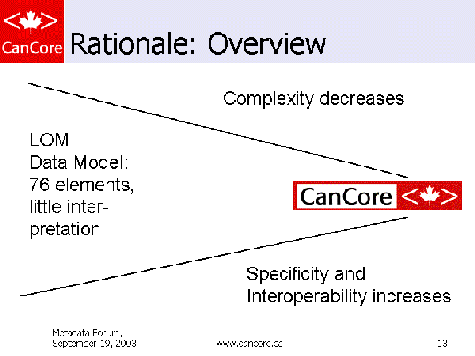
CanCore Guidelines
-
explication and interpretation of element definitions and descriptions
-
recommendations based on best practice
-
recommendations for vocabulary (or "value space") values and definitions
-
multilingual plain language examples
-
XML-binding examples
-
technical implementation notes
CanCore's Community: input
-
Academic Technologies for Learning of the University of Alberta
-
Alberta Learning
-
Athabasca University
-
British Columbia Open University
-
Centre recherché LICEF
-
CETIS UK
-
Department of National Defense, Canada
-
Eisenhower National Clearinghouse
-
The Electronic Text Centre of the University of New Brunswick
-
European Knowledge Network
-
Galbraith Media
-
Katholieke Universiteit Leuven
-
Learning and Teaching Scotland
-
Library and Archives of Canada
-
Manitoba Education and Youth
-
Memorial University
-
Ontario Ministry of Education
-
The Open Learning Agency of British Columbia
-
Stem-Net NFLD-Lab.
-
TeleEducation New Brunswick
-
University of Calgary
CanCore Guidelines

Guidelines
Example 1: Clarification

Guidelines
Example 2: Best Practice Recommendations
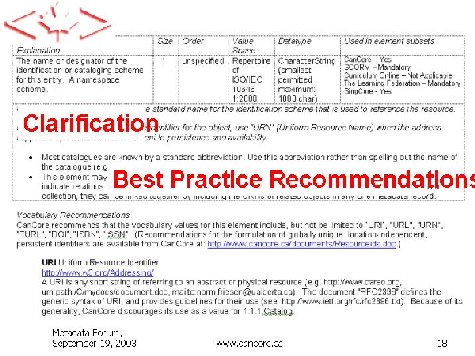
Guidelines
Example 3: Survey of Use
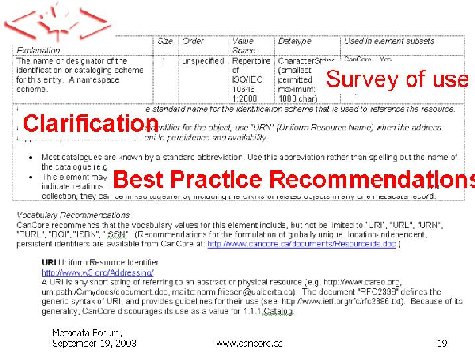
Guidelines
Example 4: Vocabulary Definitions
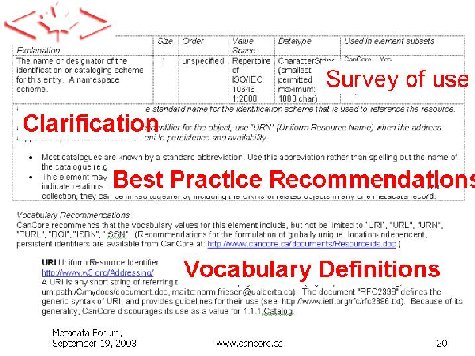
Guidelines
Example 5: Technical Implementation Notes
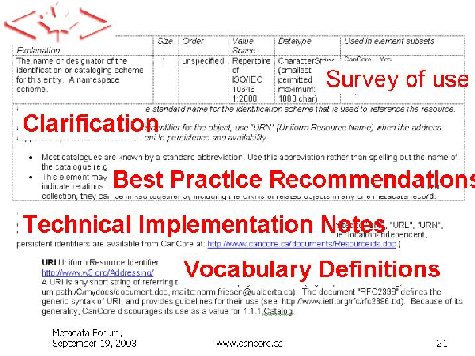
CanCore On-line Guidelines
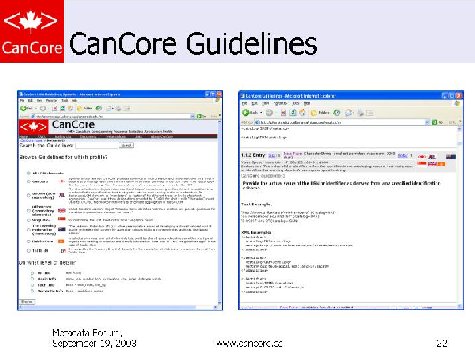
CanCore and Standards Evolution
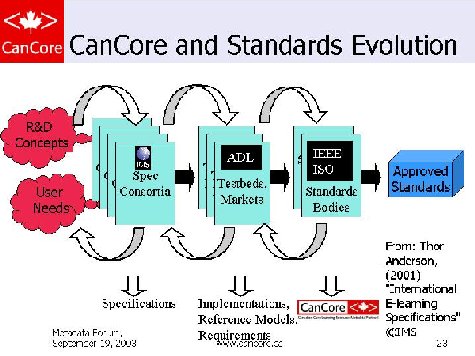
CanCore's Participation in Standardization
-
IMS: Next steps re: maintenance
-
IEEE LTSC:
-
ISO Subcommittee on "Information Technology for Learning Education and Training
-
Survey, proposal for new approach to the LOM standard.
Other CanCore/AU aids for implementers
-
http://adlib.athabascau.ca
-
Upload or link to resources
-
Simplified interface based on CanCore best practice recommendations
-
Create XML record, submit to a database, submit to AD LIB
CanCore Metadata Generator - CAREO

Other CanCore/AU aids for implementers
-
Web-based; no software to download/install
-
Portable, self-contained, linked
-
Create, store and search metadata
-
Open Source
-
Open protocols for sharing records
-
Browser-independent
Other CanCore/AU aids for implementers
- LOM Java Binding:
-
Interface or API providing functions for working with LOM data in software systems
-
Implementation neutral Java interfaces for exposing data objects corresponding to those of the LOM
-
can be used by Java programmers for representation of LOM data objects within their own software
-
as an interoperable way to communicate LOM data objects with external third party software components
LDAP LOR
-
LDAP: A network protocol designed to work on TCP/IP stacks to extract information from a hierarchical directory; a tool to comb through data to find a particular piece of information.
-
Builds a LOM record out of LDAP results
-
distributed service for resolving globally unique identifiers into their locations
LDAP LOR
- Based on functions outlined in the IMS Learning Object Repository Interoperability Specification (www.imsglobal.org):
-
Harvest, Request, Search, Submit, list Results
-
Developed for LOM data model
MARC to CanCore/LOM
-
Abstract datamodel-crosswalk developed with CanCore and MARC experts
-
Automatic conversion of MARC records to XML-formatted CanCore/LOM records
-
http://edusource.athabascau.ca/
Supporters
-
CANARIE
-
Multimedia Learning Group, Industry Can.
-
Alberta Learning
-
Athabasca University
-
University of New Brunswick
-
Office of Learning Technologies
-
TeleEducation NB New Brunswick
-
NETERA
Find out more about
CanCore at:
www.cancore.ca
|









